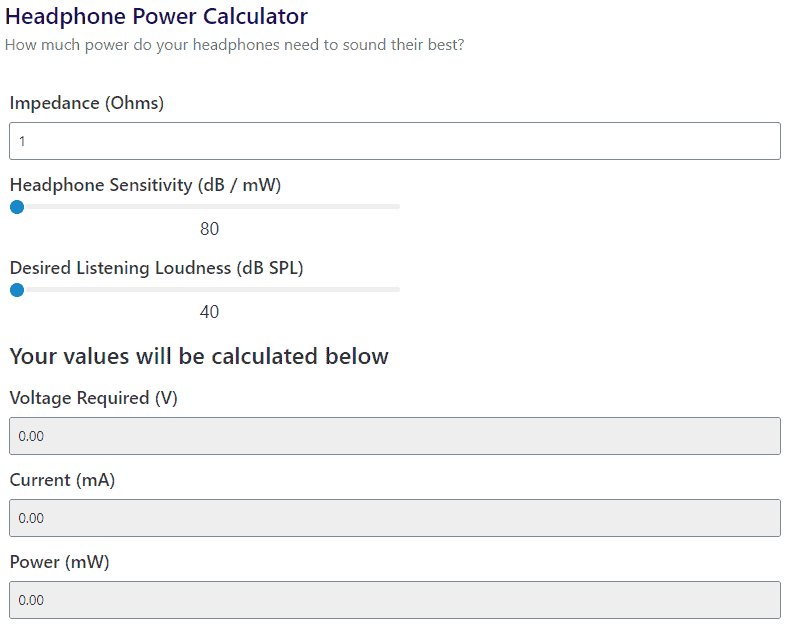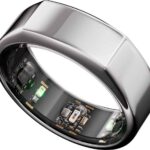Whether you’re an audiophile, studio engineer, or just want the best sound from your headphones, matching your gear correctly is critical. Not all headphones are easy to drive — some require much more power than others to reach ideal volume levels without distortion or loss of quality.
This Headphone Power Calculator helps you determine exactly how much power (in milliwatts), voltage, and current your headphones need based on their sensitivity (dB SPL/mW), impedance (ohms), and your desired loudness level in decibels. It’s a precise, data-driven way to ensure your amp or audio source can deliver the performance your headphones require.
Understanding your headphone’s power needs:
- Ensures you get clean, full-range sound
- Prevents underpowering (which leads to weak output or distortion)
- Helps avoid overpowering and potential hardware damage
The calculator is especially useful for anyone using high-impedance headphones, low-sensitivity models, or pairing with sources like USB DACs, audio interfaces, phones, or portable players. It provides essential data like required RMS voltage, peak current, and total power draw so you can confidently match your headphones with any gear.
Stop guessing — enter your headphone specs and get an instant answer. Your ears (and your headphones) will thank you.
Here’s a list of some approximate sound pressure levels in dBSPL:
| Sound | dBSPL |
| Quiet Whisper | 30 dB |
| Normal conversation (1m / 3ft) | 40 – 60 dB |
| Inside a Car | 65 – 80 dB |
| Jackhammer (15m / 50ft) | 90 dB |
| Lawn Mower (1m / 3ft) | 107 dB |
| Deafening / Human Pain Limit | 120 dB |
| Jet Airplane (30m / 100ft) | 130 dB |
| Military Jet Takeoff (30m / 100ft) | 150 dB |

A Guide to Using the Headphone Power Calculator
Power and Sound Quality
Headphones need the right amount of power to truly shine. Too little, and the sound might feel flat and lifeless; too much, and you risk distortion that muddies the music. It’s all about finding that sweet spot where the headphones translate electrical power into crisp, clear sound pressure levels (SPL), measured in decibels (dB).
The Amplifier
Choosing the right amplifier is like finding the perfect dance partner for your headphones. It’s about matching the power output of the amp to the unique characteristics of your headphones – their resistance (impedance) and how efficiently they convert power into sound (sensitivity).
High-impedance headphones might need a little extra push, so an amplifier that can deliver that power without breaking a sweat is crucial. It’s about ensuring your headphones get the juice they need to sing their hearts out.
Sensitivity
Headphone sensitivity, often expressed in dB SPL/mW or dB SPL/V, reveals how loud your headphones will get with a certain amount of power. Think of it as a volume knob built into the headphones themselves.
Knowing this value helps you figure out if your audio source can pump up the volume without pushing your headphones too far. It’s about enjoying your music at a comfortable level without risking damage to your ears or your gear.
Calculating and Adjusting Volume
Figuring out the ideal power for your headphones isn’t rocket science. Here’s the game plan:
- Check your headphone specs for sensitivity and impedance.
- Plug those values into our handy Headphone Power Calculator.
- The calculator does the heavy lifting, crunching the numbers to tell you the perfect power needed for your preferred volume.
- Start low and slowly turn up the volume on your amplifier until you find that perfect balance of clarity and oomph.
Audio Sources
Different audio sources pack different power punches, which can significantly impact how your headphones perform.
| Audio Source | Typical Power Output (mW) |
|---|---|
| Smartphone | 10-30 |
| Laptop | 20-50 |
| Portable Music Player | 30-100 |
| Dedicated Headphone Amplifier | 100-1000+ |
Knowing the power output of your source helps you choose headphones that will sing beautifully, not struggle to be heard.
Impedance
Headphone impedance, measured in ohms, is like a hurdle for the electrical signal. Higher impedance means more resistance, which often translates to needing more power to reach the same volume.
Low-impedance headphones are easier to drive, making them a good match for portable devices like smartphones. High-impedance headphones, on the other hand, might need a dedicated amplifier to unleash their full potential but often offer better sound quality and detail.
Power and Battery Life For Wireless Options
Wireless headphones have their own power game, thanks to built-in amplifiers. These amps need juice to keep the music flowing, which can impact battery life.
If you crave those powerful bass drops and soaring vocals, be mindful that it might drain your battery faster. Consider headphones with larger batteries or efficient power management if you’re a heavy listener.
Troubleshooting: When the Music Stops
Sometimes, even the best audio setups hit a snag. Here are a few common power-related hiccups and how to fix them:
- Low Volume: Check your source’s volume settings and make sure your headphones are properly connected. If you’re using a dedicated amplifier, ensure it’s turned on and the volume is adjusted correctly.
- Distortion: This usually means you’re overloading your headphones with too much power. Lower the volume on your source or amplifier.
- No Sound at All: Double-check all connections and make sure your audio source is working correctly. If you’re using wireless headphones, ensure they’re charged and paired with your device.
Key Takeaways
- A Headphone Power Calculator helps determine if an audio source can power headphones effectively.
- The tool considers headphone sensitivity and impedance to recommend the necessary power settings.
- Understanding the power requirements enhances audio experience and prevents headphone damage.
How To Use Our Calculator
Our headphone power calculator is designed with user-friendliness in mind. Here’s how to navigate it:
- Input Fields: Start by entering your headphone’s specifications, including impedance and sensitivity.
- Desired Loudness: Adjust the loudness to your preference. Remember, prolonged exposure to high volumes can be harmful.
- Results: The calculator will display the required power, voltage, and current for your headphones.

Key Terms Explained
- Impedance: Measured in ohms, it represents the opposition to current in AC circuits. Generally, higher impedance headphones require more power.
- Sensitivity: This indicates how loud your headphones will sound at a given power input. It’s usually expressed in dB SPL/mW or dB SPL/V.
Tips for Getting The Best Results
- Know Your Headphones: Always refer to your headphone’s manual or the manufacturer’s website for accurate specifications.
- Safety First: While it’s tempting to crank up the volume, always prioritize your hearing health.
- Experiment: Play around with different loudness levels to find your sweet spot.
Understanding Headphone Power Requirements
When matching headphones with audio sources, understanding power needs is essential to achieve the best sound quality without causing damage to the equipment.
The Basics of Headphone Power
Headphones require a certain amount of power, measured in milliwatts (mW), to produce sound. This power comes from an audio source such as a smartphone or an amplifier. The sensitivity of headphones, usually listed in the specifications as dB/mW or dB/V, determines how loud headphones can get per unit of power. Another critical factor is impedance, measured in ohms; this is the resistance the headphones give to the electrical signal. A higher impedance means that more voltage is needed to achieve the same loudness as a lower impedance headphone.
Calculating the Power Needed for Optimal Performance
To calculate the power a headphone needs, you can use a headphone power calculator. This tool helps to determine the required power by entering the sensitivity, impedance, and desired loudness level (in dB).The formula to calculate power is not always straightforward as it involves multiple electrical aspects such as voltage, current, and resistance. Still, the calculator simplifies it into an understandable outcome, often given in watts.
Identifying Sources of Power for Headphones
The sources of power for headphones can include a variety of devices ranging from portable music players to dedicated headphone amplifiers. Each device has a maximum power output it can deliver. For example, smartphones typically have lower power outputs compared to standalone amplifiers. It’s essential to know the output capacity of the device to match it correctly with your headphones.
Guidelines to Prevent Headphone Damage
While trying to achieve the best volume and sound quality from your headphones, it’s vital to prevent damage. The constant flow of too much power can harm the headphone’s design and electronics. Always start at a lower volume and gradually increase it to find a comfortable level. This approach not only helps protect the headphones but also your hearing. Monitor the audio source to ensure that it does not output more power than your headphones’ rated capacity.
Optimizing Audio Experience
To get the best sound from your headphones, it’s important to understand the relationship between power and sound quality and how to use a Headphone Power Calculator correctly.
Relating Power to Sound Quality
Headphones need the right amount of power to deliver high-quality audio. Too little power and the sound may be weak; too much can lead to distortion. Sound quality is greatly influenced by how well the headphones turn electrical power into sound, which audiophiles refer to as sound pressure level (SPL) measured in decibels (dB).
Selecting the Right Amplifier
Just like finding a pair of shoes that fit, selecting an amplifier requires matching the power output of the amp to the resistance and sensitivity of your headphones. Headphones with high resistance may need more power, so the chosen headphone amplifier should be able to provide this without sacrificing the loudness and quality of the sound.
The Importance of Headphone Sensitivity
Headphone sensitivity, usually listed as dB SPL/mW or dB SPL/V, tells you how loud headphones will be for a given input. This number will guide you in judging whether an audio source can drive your headphones to the desired volume without causing damage.
Practical Steps to Calculate and Adjust Volume
Calculating the needed power is simple:
- Find your headphone’s sensitivity and impedance values.
- Use those values in a Headphone Power Calculator.
- The Calculator will use these to determine the right power needed for your desired volume.
Adjust the volume on your amplifier carefully, starting at a lower level, to find the sweet spot where your music sounds clear and detailed.
🎧 More About Headphone Power and Audio Matching
Understanding power needs is about more than just volume — it’s about fidelity. Underpowering headphones often leads to weak bass, poor dynamics, and distortion at higher volumes. Overpowering can fry the drivers or cause clipping.
When evaluating headphone performance, also consider:
- Voltage swing: Some high-impedance headphones require more voltage than most portable devices can supply.
- Current demand: Low-impedance headphones (like 16Ω) often need higher current, which some sources struggle with.
- Damping factor: A low output impedance from your amp (ideally under 1Ω) gives better control of the headphone driver movement, especially with low-impedance models.
Finally, remember that perceived loudness isn’t linear. A 3 dB increase requires double the power, and a 10 dB increase requires 10 times more power. That’s why pairing the right source with your headphones is so important — and why this calculator exists.
FAQs
What does a headphone power calculator actually do?
It estimates how much electrical power (in milliwatts) your headphones need to achieve a specific loudness level, based on their impedance (Ω) and sensitivity (dB SPL/mW). This helps determine if your audio source or amp can properly drive your headphones.
How do I find my headphone’s impedance and sensitivity?
These values are usually listed in the technical specs on the product box or manufacturer’s website. Impedance is measured in ohms (Ω), and sensitivity is measured in dB SPL per milliwatt (often dB/mW or dB/V).
Why does headphone sensitivity matter?
Higher sensitivity means the headphones can reach loud volumes with less power. Lower sensitivity headphones (under 95 dB/mW) usually require a dedicated amp, especially if paired with high impedance.
Do I need an amplifier for my headphones?
It depends on your headphone specs and your audio source. High-impedance (>100Ω) or low-sensitivity headphones may sound quiet or flat without an amp. A power calculator helps you figure this out.
What if I’m using a phone or laptop?
Most smartphones and laptops only output 1–20 mW into standard loads. If the calculator shows your headphones need more than that, you might not get the best sound without an amp or DAC.
Does EQ affect power requirements?
Yes. Boosting bass or treble increases power demand at those frequencies. The more aggressive your EQ curve, the more headroom your amp or source needs to deliver clean audio without distortion.
Can I damage my headphones by overpowering them?
Yes. Feeding too much power into headphones can cause permanent driver damage. The calculator helps prevent this by letting you match power output to what your headphones are designed to handle.
Are wireless headphones affected by this?
Not really. Wireless headphones have their own built-in amps designed to match their internal drivers. Power calculators are primarily useful for wired headphones connected to external gear.







